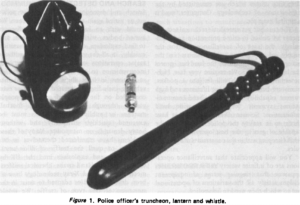Law enforcement generates extraordinary amounts of data. Every call and dispatch, every arrest, and most interactions with civilians create data an agency can use for analysis. Historically, the practical application of this information has been limited to crime analysis and prevention (e.g., hot-spot policing), but the increasing availability of data and analytics makes it possible for agencies to apply similar strategies to technology-driven personnel management.
Law Enforcement’s Data Ecosystem
Much of an agency’s data is captured through deeply integrated platforms such as Computer-Aided-Dispatch (CAD) and Records Management Systems (RMS). The emergence of CAD and RMS allows police leadership to streamline everyday operations while tracking patterns in historical data to develop sophisticated proactive strategies for crime prevention.
As agencies continue to upgrade to digital systems – including the deployment of equipment like body-worn cameras, dashcams, and V2X telemetry – it becomes easier to derive insights from officer activity. New technologies overlay existing systems to create a digital ecosystem that produces an increasing volume and quantity of data. This growth makes analysis more important, more complicated, and much harder to do well. However, it also creates an opportunity to do more with agency data.
For example, an agency could expand the focus of its data analysis beyond a criminal lens to include performance management of its officers. A recent article by Michael Armstrong, Bill Bratton and Sean Malinowski:
Performance Management has been described as an ongoing process to establish and maintain a high performance culture, focused on aligning individual objectives with the overall goals of the organization. Performance Management is characterized by inclusion and agreement on goal setting, establishing standards of measurement and immediate and ongoing collaboration and feedback. (Armstrong, M. (2006). Performance Management. London: Kogan Page)
In other words, performance management is effectively working with your officers, leveraging strengths and managing weaknesses to improve the overall outcomes of your agency’s police work. This begins with identifying what data to capture, how to effectively do so, and what the data you collect actually means. Most departments have an abundance of officer data but very few have managers trained to conduct meaningful data analysis.

In a previous blog, we connected this analysis of data to agency transformation (see the 5 Stages of Transformative Management for Law Enforcement). We mapped a typical agency’s journey from an undefined process to a transformative one and the distinct stages in between (including analytic). Well-documented processes with automated data collection get agencies pretty far along the path – without this data, you’d have nothing to analyze – though it takes more than just data to transform an agency. Each data point is like a rain drop. When you have a documentation process in place, you can get to the point where you know it’s raining and intuit how much rain is falling. It is Analytics that provides you with the information to decide whether or not you need an umbrella.
Using Analytics to Generate Actionable Insight
In this context, analytics refers to both the approaches and the software that can process massive amounts of varying data types within set parameters (provided by a user) to uncover patterns – achieving a level of insight that would be prohibitively difficult to do without the assistance of a computer. Law enforcement has used analytics to explore tactics to advance the efficacy of policing. This is only possible because of the data created by officers, both digital and not. At this level, an agency is just asking its officers to do paperwork. Necessary, no doubt, if only to have a chain of documents to audit. But agencies could be using this information to help officers get better at their jobs.
For the individual officer, analytics can guide continuous growth and improvement. How you measure this progress will depend on what standards your agency implements, but generally speaking, observable “growth and improvement” is any behavior that moves an officer up and to the right from whatever baseline expectations you set for them. If data indicates an officer is more likely to use force during third watches, you might consider evaluating them for sleep hygiene or avoid assigning them to third watch. It could be this individual is less likely to de-escalate when their natural sleep patterns are disrupted. Or maybe additional training paired with mindfulness coaching could be part of the solution. Instead of policy-driven management – which operates on whether an officer is following the rules or not – we can use data analysis to understand what behavior, coupled with training, leads to the best overall outcomes for an officer and the community.
This is similar to the type of ongoing growth we expect from other industries. Doctors are evaluated by their outcomes as well as subjective factors like bedside manner and perceived empathy. The same could be said for teachers, who receive regular evaluations from students and have access to myriad professional development opportunities. There is a distinct difference between an average doctor and an exceptional one; a teacher with room for improvement, and one voted Teacher of the Year.
Beyond certification for weapon and tactical systems, officers grow and improve throughout their careers. Officers are continuously refining their approach to interacting with the civilian population and each other. Yet this process of improvement is often independent of explicit agency guidance. Officers grow (or not) on their own, absent the same type of regular feedback and guidance from supervisors typically considered table stakes in other professions.
How can supervisors use data to help officers improve?
We can apply analytics to four areas of law enforcement: understanding what types of people tend to be exceptional police officers; identifying an agency’s best officers to help supervisors develop models for professional development; gauging the impact of trauma exposure on officers; and identifying and addressing behavior patterns that are likely to precede adverse events with civilians.
Policing is a difficult job. Successful officers project empathy and power simultaneously while responding appropriately to rapidly evolving situations. In the same way everyone isn’t built to play professional football or achieve Grandmaster status in chess, not every person is wired to be an officer. In theory, anyone can throw a football well or recognize opportunities on a chessboard – some just come by these skills more naturally.
Over time, we can begin to understand why certain individuals get things wrong and how others can learn from it. The stakes are undoubtedly high: mistakes can put an individual officer at risk as well as members of the community. Yet through the use of data, agencies can provide tailored, outcome-specific feedback to individual officers based on their own unique profile so they can improve. 
To get these results, agencies have to familiarize themselves with the limitations of certain types of data processing. It’s a step in the right direction whenever an agency implements a process for objective self-evaluation. However, some methods for using data to manage officers that were once thought to be effective are no longer reliable sources of insight.
Beyond trigger-based personnel management
A primary example of using data more effectively to manage and support officers is the use of early warning systems. Since the 1970’s, agencies implemented early warning systems to flag officers acting outside a predetermined norm. Supervisors configured the system’s “triggers” using a blend of experience and intuition. Research has shown this approach is ineffective: trigger-based systems fail to correctly identify off-track officers. Further, they focus solely on what not to do rather than what officers could be doing to improve.
Data Science empowers us to move beyond these simple mechanics. Instead of intuition, we can use insight generated through rigorous analysis of longitudinal data. This enables an agency to provide tailored management to its officers. This leads to more effective policing and by extension a safer, and engaged, community.




 To ensure paper becomes the exception to the rule, your team
To ensure paper becomes the exception to the rule, your team  Last year California legislators
Last year California legislators  One of the best use cases for software is automation. Remember what it was like when you had to dial someone’s number? Now you can just tap a contact’s name. The same logic plays out in the latest technology. You’ll be able to configure any enterprise software to automatically complete your data-related tasks. Whether it’s capturing data in real-time or performing analysis on it, software tackles the drudgery, leaving the critical thinking to you and your leadership team.
One of the best use cases for software is automation. Remember what it was like when you had to dial someone’s number? Now you can just tap a contact’s name. The same logic plays out in the latest technology. You’ll be able to configure any enterprise software to automatically complete your data-related tasks. Whether it’s capturing data in real-time or performing analysis on it, software tackles the drudgery, leaving the critical thinking to you and your leadership team. Tomorrow’s police executives patrol today’s streets. These future leaders look to you and your executive team to define what it means to be a police officer, and they will carry that interpretation with them into future management roles. This is why it’s critical to identify these natural leaders sooner rather than later. People data won’t explicitly pinpoint the officers in your agency who have the makings of a future chief, but a combination of intuition and data-backed insight can guide your focus to high-performing officers with the traits and track records that should be recognized and cultivated.
Tomorrow’s police executives patrol today’s streets. These future leaders look to you and your executive team to define what it means to be a police officer, and they will carry that interpretation with them into future management roles. This is why it’s critical to identify these natural leaders sooner rather than later. People data won’t explicitly pinpoint the officers in your agency who have the makings of a future chief, but a combination of intuition and data-backed insight can guide your focus to high-performing officers with the traits and track records that should be recognized and cultivated. Whether we notice it or not, our peers shape the way we perceive the world, and in a police department that can be problematic if that world-view doesn’t align with yours or the public’s expectations for your officers. Using people data, you can evaluate what types of behaviors perpetuate across your agency and determine whether those are in line with values you champion as an agency. If they don’t, the data should give you a head start on correcting these issues before the inertia makes it difficult to intervene.
Whether we notice it or not, our peers shape the way we perceive the world, and in a police department that can be problematic if that world-view doesn’t align with yours or the public’s expectations for your officers. Using people data, you can evaluate what types of behaviors perpetuate across your agency and determine whether those are in line with values you champion as an agency. If they don’t, the data should give you a head start on correcting these issues before the inertia makes it difficult to intervene.